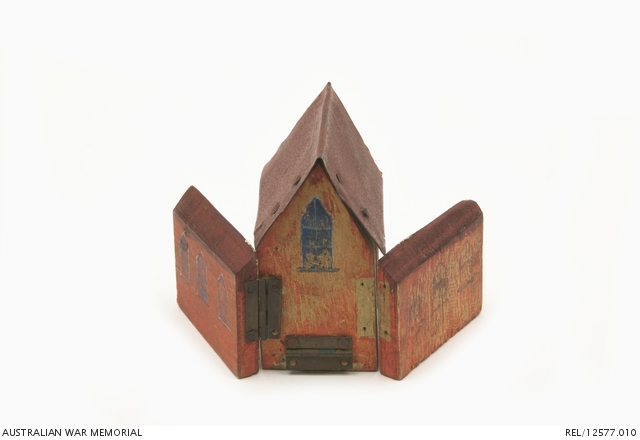| Accession Number | REL/12577.010 |
|---|---|
| Collection type | Technology |
| Object type | Model |
| Physical description | Metal, Paint, Wood |
| Maker |
Read, William Henry |
| Place made | Australia: New South Wales, Sydney |
| Date made | 1942-1943 |
| Conflict |
Second World War, 1939-1945 |
Model Air Raid Warden Training Buildings - hinged exploded church



Wooden model of a church which is designed to hinge into an "exploded" building. The four parts of this building include the back wall to which is nailed the red tin roof and three hinges (one is missing); the front wall of the church which includes a covered porch; and two separate sides. The exterior is painted an orange/red colour; the windows (three on each side, one on the rear and three on the front) a purple/blue with a silver outline, and the interior is cream. The side and front walls of the church are designed to hinge outwards.
Collection of twelve (12) painted wooden and metal buildings representing houses, churches and civic buildings, some with bomb damage. They are meant to represent the section of the northern Sydney suburb of Wahroonga for which Dr William Read was the responsible warden and were regularly used for weekly Air Raid Precaution (ARP) training and large scale exercise planning sessions at his home at Cleveland St, Wahroonga. A keen carpenter, Dr Read created the buildings, originally based on a board painted to represent the streets in his suburb, and his daughter states "He used these to play 'war games' with his fellow wardens and had them set up on the verandah of his home." This model of a church represents St Andrew's Church of England at the corner of Cleveland and Water Sts, Wahroonga, where Read's daughter Margaret had been married in 1933. The church was replaced after 1945. Dr Read had served in Egypt at No 2 General Hospital with the Australian Army Medical Corps (AAMC) during the First World War, to the extent of moving his wife and three children to Cairo to be close to him. Upon his return to Australia, he ran the Hospital at Georges Heights which had been set up to receive the Gallipoli wounded.
Related information
Conflicts
Subjects
Related Objects
- Model Air Raid Warden Training Buildings - homestead
- Model Air Raid Warden Training Buildings - two story home with verandah
- Model Air Raid Warden Training Buildings - two story redbrick bungalow with garden
- Model Air Raid Warden Training Buildings - wrecked two story bungalow with exposed rooms
- Model Air Raid Warden Training Buildings - cream house with circular hole in the roof
- Model Air Raid Warden Training Buildings - two story cream bungalow with hole in side
- Model Air Raid Warden Training Buildings - small two story gabled house
- Model Air Raid Warden Training Buildings - small house with lean-to and high pitched roof
- Model Air Raid Warden Training Buildings - town hall tower
- Model Air Raid Warden Training Buildings - church with tower